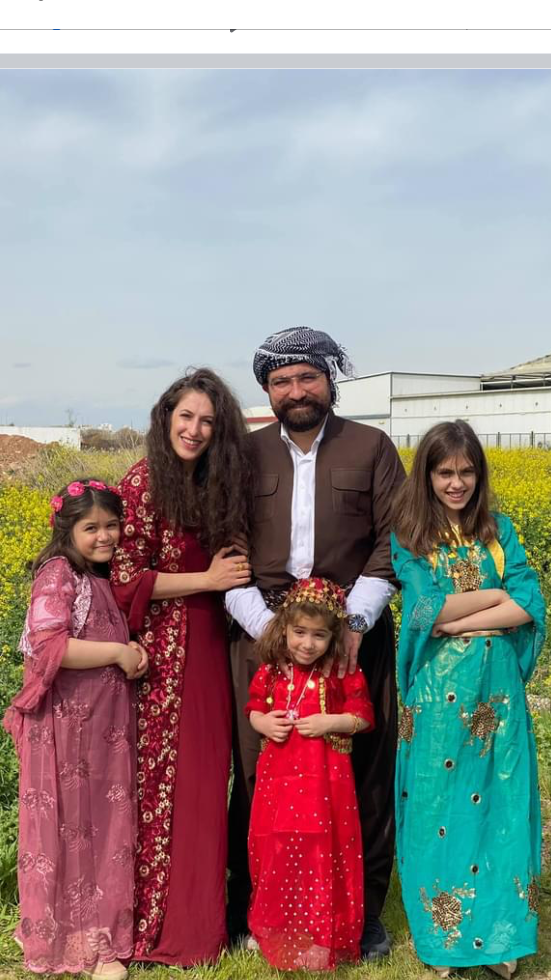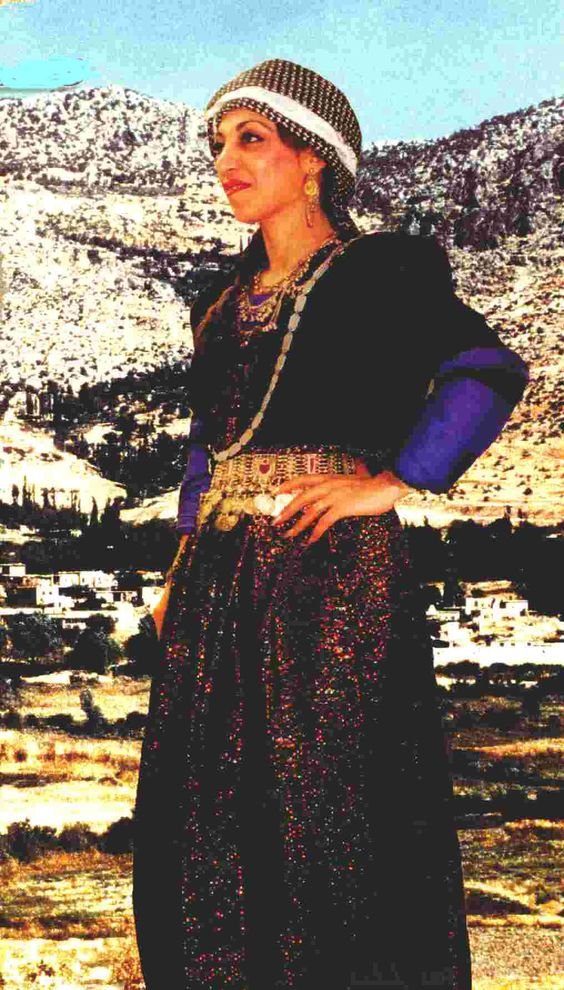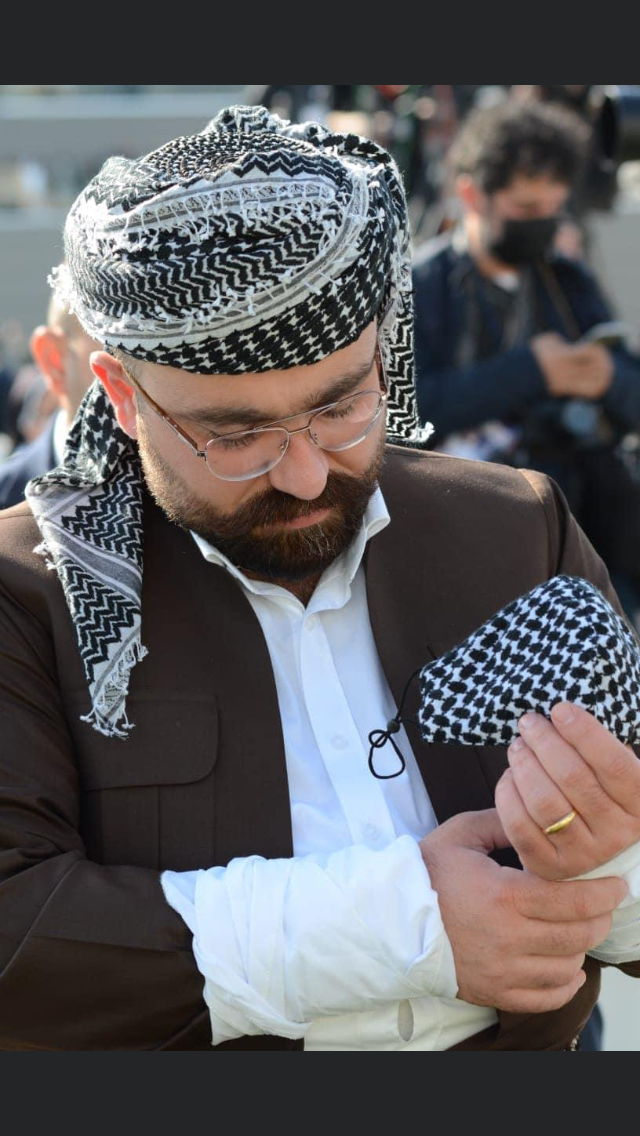We Are What We Wear: Part II
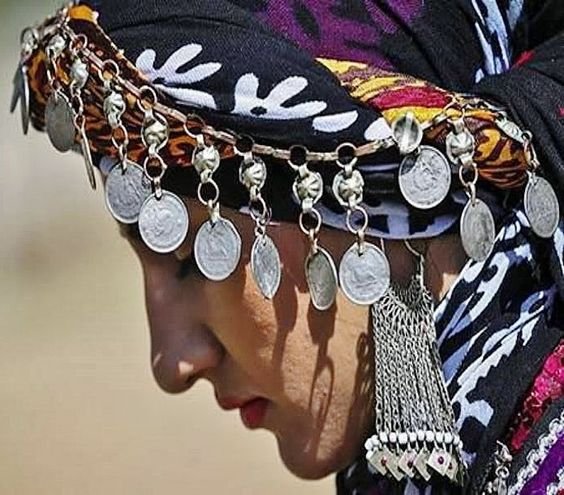
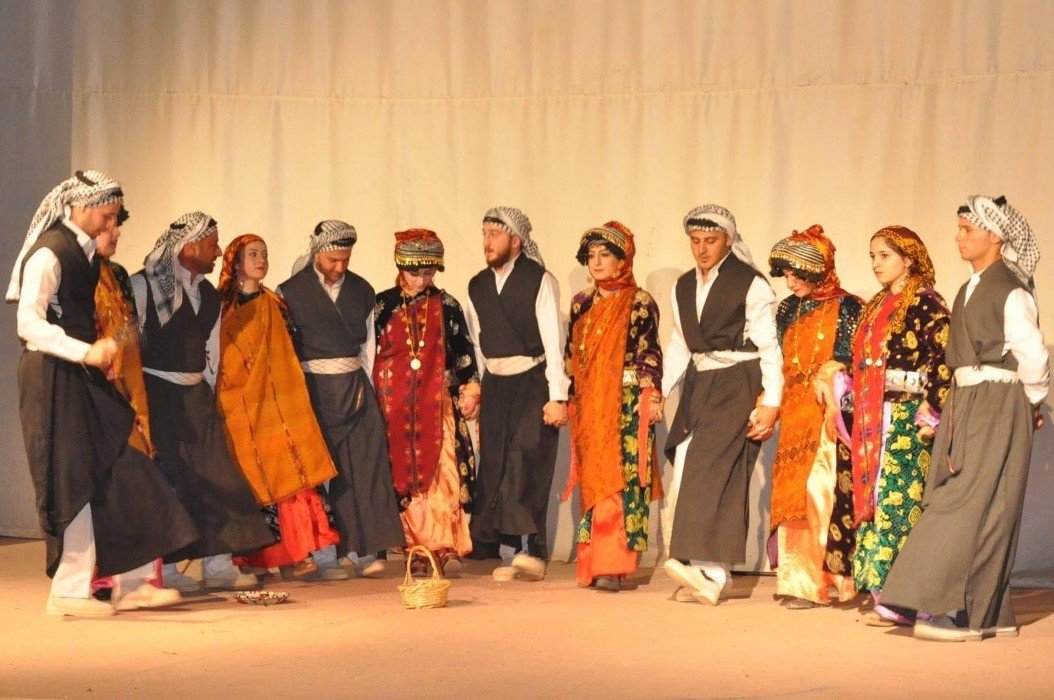
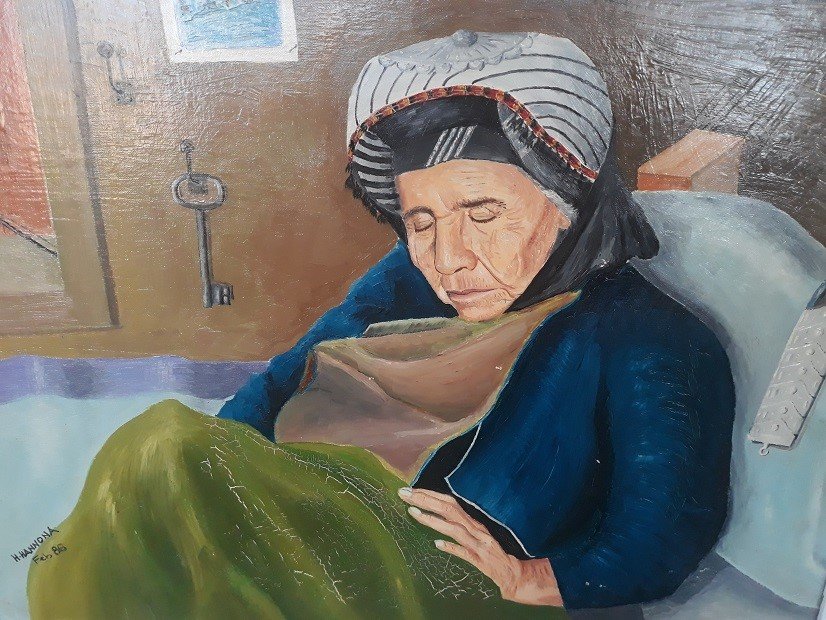
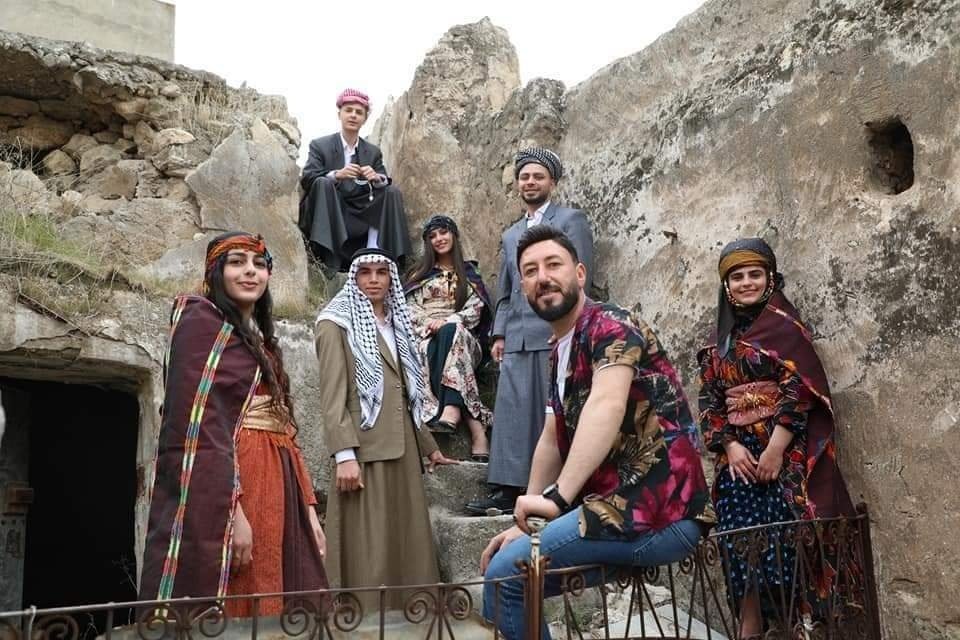
Christian village costumes and town variations
by Dr. Adhid Miri
Part II
Costumes are an important part of the history of our heritage. They express our traditions, reflect the nature of our environment, its diversity, and the beauty of its colors. Costume styles are associated with the development of life, agriculture, work, and the needs of the village.
Traditional costumes differ from region to region and village to village for reasons related to the environment, class structure, economic capabilities, neighborhood, marriage, and wars and invasion.
Some similarities exist between the Chaldean names for clothing pieces among neighboring towns and villages, such as the Maizer, the Shawl, the Basslma, and the Shamlah, which are different names for a single piece that hangs from one shoulder and on to the back, chest, and abdomen on a woman’s side.
Although the Maizer is a common piece among many folk costumes, it is distinguished between villages by fabric, size, decoration, and color.
The Magroma, the Bushia, the Kasrwan, the Kalutah, and the Kosita are large, colored scarfs made of silk fabric, sometimes embroidered with gold or silver coins, and worn as a head covering. The forehead is decorated with chains of gold and silver pieces hanging from behind the eyebrows or attached to the ears called Biski, Garmogi, Na’auri, Boyki, Gorngi, Keratha, or Titia.
Women wear necklaces of gold and silver coins called Girdana, Jarjar, Hulqiatha, or Zanqa with rings made of brass or gold liras.
In part II of our village’s costumes story “We are What we Wear,” we will cover a few more Christian villages in northern Iraq.
Ankawa
Ankawa is a suburb of Erbil in Kurdistan region of Iraq. It is located 8 kilometers northwest of downtown Erbil. The suburb is predominantly populated by Chaldeans who adhere to the Chaldean Catholic Church.
Women’s costume: Ankawa shares little in common with neighboring villages when it comes to women’s costumes. There are differences with the colors, jewelry, decorations, and inscriptions. Elderly mothers and younger women wear very different styles of headdress, which vary by both color and accessory.
Women’s clothing consists of a long robe that stretches from the shoulders to the feet, with a small opening at the neck, long sleeves, and cuffs that are connected and held behind the back, called Shouqtta. Another long robe is worn over it, which is completely open from the front, with two side pockets and two openings from the lower sides called Qabaya. On top of that is the Fermaniya, a thick, short jacket that goes down to the hips. It stays open from the front, has long cuffs, and its edges are embossed with golden and silver threads.
Under the Shouqtta, women wear long pants that are wide near the waist and knees but narrow around the ankles and feet. The waist is tightened with a belt consisting of several gold or silver discs called Kamar.
The Basslma is a piece of thick, black-colored cloth with beautiful decorations, embroidered with indigo blue threads for the elderly. Young women use cloth with the dowry color and includes embroidery in many different bright colors. Often, these adornments feature religious symbols such as crosses, birds, and flowers. The cloth piece is affixed to one shoulder and hangs under the arm. The Hamlala, a large silver chain attached to the shoulder which hangs under the other arm, is situated above the Basslma. This accessory is small and square-shaped, designed to hold a few silver pieces or crosses. At the bottom, a large disk bears pictures or religious symbols.
The Ezarta or Ezarah is a piece of cloth which has a small white and dark gray square design and is about a meter and a half long. Older women usually wore a shorter cloth. When attending church, younger women used a striped or embossed piece of cloth as a head covering, referred to as an Eizar, while young girls wear a small scarf. The traditional black Arab, called Abaya, was never common in Ankawa in the past.
The head covering for young women is called Kositha d Bnatha or Risha d Bnatha, which is a black cap, Keleta or Kalouta, with a bowl-shaped top engraved with gold or brass, depending on the family’s wealth. It is wrapped with several layers of scarf with lacy edges.
The head scarf, Magroma, is colored olive-golden, from which a colorful thread necklace hangs for married women. The bachelorette girls wear a cap with a bowl made of silver and gold, surrounded by colored silk handkerchiefs studded with golden pieces that protrude from the side of the forehead.
The under shirt/dress Shouqtta is made of different fabrics and covered with a Qabaya and topped with Basslma which is a kind of Shawl that is held above the right shoulder and descends under the arm.
Accessories surrounding the head are made of compact crescent pieces of gold called Garmuka, pieces of gold hanging from both sides to cover the ears are called Biske, and the neck is decorated with Girdana. Earrings look like a ring with a necklace resembling a pomegranate called Na’aouri, and the hand accessory is called Sherry.
Ankawa women are known to wear very colorful clothing and gradually turn to darker colors as they get older. The way they dress on Sundays, happy occasions, and weddings is an expression of happiness for youth. Mothers and the elderly wear the usual clothes with a head covering and do not take them off except when sleeping.
Men’s outfit: The men’s traditional costume in Ankawa is like that worn in nearby villages, the traditional dress of most people of the region, which dates to the ancient tribes and nationalities that inhabited these areas. The local character and men’s clothing are among costumes collections spread in all the mountainous regions and the nearby plains.
This men’s outfit is composed of the Kartak, Sherwal, Sharata and a head piece called Mishki or Jamdan. Some men wear a white shirt that is slightly open from the chest with two long sleeves that are wrapped around the wrist under a Kurta, which is a jacket open in the front made of thick lined fabric that has two pockets on one side of the chest and two side openings. The Kurta goes down to the hips.
From the waist down, men are covered with loose pants that are worn wide at the waist and narrow at the feet. A long, thick belt type piece made of is worn around the waist and is knotted from the front. It is called Shrarta and can measure four meters or longer.
The head piece is a colored Kaleta or Kalutta wrapped with Jamadan or Mishki that is black with stripes, or Mahriyya, with twisted edges.
Most of the elderly men wear the Saya - Qabaya, which is a long robe extending from the shoulders to the feet, open from the front over a white shirt, slightly open at the neck, with two cuffs wrapped at the wrist. They also wore long white pants that stretch to the feet. The waist is bound by a leather belt and Fermani, a thick jacket that is open in the front and has long sleeves which are open wide at the ends, is worn over Al-Saya.
Shaqlawa
Shaqlawa is a historic city and a hill station in the Erbil Governorate in the Kurdistan Region of Iraq. Shaqlawa, a city of approximately 25,500 people, sits 51 km to the northeast of Erbil at the bottom of Safeen mountain.
Women’s dress: The head is covered with a silver bowl surrounded by colored handkerchiefs called Kfukusyatha. One of these handkerchiefs is called Shadda which is black in color with an olive frame and a Kfuki necklace.
Mashji is a pair of black handkerchiefs striped with beige and then woven from cotton. It is made of three red, green, and yellow silk handkerchiefs that surround a silver top bowl, making it collectively a head covering called Poushiyaya, which is adorned in the front with colored beads called Bulbly hanging from both sides of the face as well as the Biski which are gold discs from which longitudinal pieces hang on the cheeks and are sometimes replaced by tufts of hair. A black embroidered Eizara extends from the zenith of the head and is called a Jaruga.
The Shouqttata has long cords that are pulled behind the neck and it is girded with a belt called Khurkhasa. The Qabaya is studded with silver ornaments from the neck to the knees, with underpants called Dilnky, which are wide, loose on top, and narrow at the ankle. Accessories such as the Girdana on the neck, Golby on the hand, and Qalshiyatha on the ears are common additions.
Men’s clothing: The traditional men’s dress consists of Shouqtta or a shirt over it, a Jokhi. The pants are called Rangi, made of goat’s yarn, and tied with a belt called Khurkhasah, while the head is covered with Kosita or Jamdan.
Karamleshmles
Karamleshmles is a Chaldean town in northern Iraq located less than 18 miles southeast of Mosul. Karamleshmles and its surrounding many hills make up the historical Chaldean city of Kar-Mullissi, which means “the city of Mullissu” in Akkadian.
Women Costumes: Women’s dress consists of the Shouqtta, the Qabaya, and the Fermana made of georgette fabric. The arm sleeves are Sosikiatha. Kamar is made of silver and inlaid with violet, called Baftti. If it has a prominent inscription, it is called Kijourma. A silver knife is attached to one of the sides.
The Shawl is woven in different shapes and colors. It is knotted from the top of the right shoulder and covers half the body. The pieces woven from wool are called Shibaqa.
The head is covered with a bowl, Kalouta, and inlaid with ancient silver coins such as Indian rupees. A Kasrawana and Qoqwatha are wrapped around it and decorated with a red bead, Kasny, and a center piece with three light circular lobes Parpari placed on top of the Qoqwatha.
The Showrabi and Bisky are golden rings placed over the Poushiya. The Ghazi and al-Nutoptha liras have three blue lobes, all of which adorn the Poushiya.
As for Izrani, they are pieces of gold that look like almonds, with hooks to tighten the Hibriya. The neck decorations are called Jirjir with earrings in the form of a ring hanging from them called Rish-natha, all made of gold.
Bakhdida-Qaraqosh
Bakhdida in Sourath, Qaraqosh in Turkish, also known as Al-Hamdaniya in Arabic is a Catholic Syriac city within the Nineveh Governorate, located about 32 km southeast of the city of Mosul and 60 km west of Erbil amid agricultural lands, close to the ruins of the ancient Assyrian cities Nimrud and Nineveh.
Women’s traditional dresses: The women’s traditional costume in Bakhdaida consists of four main pieces: an under dress, Shouqttata, which is the longest inner piece, the Qabaya Zibon, which is the second layer, shorter than Shouqttata, which is usually brown in color with a floral design and a border all around the edges. Fermana is the third waist-length piece, pink in color, woven from lamb wool called Karamleshk, and the belt is called Hayasa which is made of linen and silk. If made of woven wool, it is called a Zenara and on special occasions, the Kamara is used, which is made of silver.
A Shawl is worn above all the other three pieces, and an embroidered one is worn on special occasions. The Shawl covers half the body lengthwise and is held over one of the shoulders only, usually decorated with various inscriptions and ornaments, in which the Assyrian rose stands out, reaching ancient shapes and carvings. A plain Shawl is for casual use only.
The head piece is covered with a Keffiyeh Khamuk, on which rings of gold or silver are hung. Over the Khamuk, the women of Bakhdaida place a Qunja. Over the Mistarta there is a long band made of fabric, called Azran, which is decorated with silver and gold and placed over each handkerchief of silk called Hibriya.
Men’s outfits: The male traditional dress consists of three main pieces: The Sarwal is the inner piece. It’s like western pants but wider for easier movement. Over the Sarwal, men wear a long sleeveless vest known as Zibon, which has an open front and two little side openings on the lower sides. The edges around the Zibon are decorated with a cord.
The Demir is a shorter waist-length piece that men wear over Zibon with full sleeves and a front opening, bordered with a cord.
Other accessories are Takiya which is a little woven cap covering the top of the head. Ghutra is a white, delicate, square scarf. When worn, it is folded diagonally to form a triangle and worn on the front side of the head. Jamadani is a thicker and machine-embroidered head scarf that comes in red or black on a white background and is worn mostly in the wintertime.
Iqal is a black rope-like double band worn over Ghutra or the Jamadani to hold it in place. Khachia is a woven cloak worn over the main pieces in spring or fall when the weather is cooler. The Farwa is a locally-made thick coat of sheepskin worn in winter.
Bartella
Bartella is a town that is in the Nineveh Plains in northern Iraq about 21 kilometers east of Mosul. Bartella was liberated from ISIS control on Oct. 20, 2016 by Iraqi Special Operations Forces and Nineveh Plain Protection Units.
Women’s dress in Bartella: Women cover their head with Qouchma, which consists of three pieces. The first is a bowl made of silver, used by girls only, in addition to a silk handkerchief called Abda or Kesrowan in which there is a Kookie, decorated with colored beads called Maqwama and a red Kisani. Beneath it, a fiery-colored handkerchief called Hebbria and the Qabaya is worn above Al Shuqata and then the Yalag-Vest made of velvet Qadifa, which is called Fermana.
The Shawl Mashoudi is often made of yellow material and embroidered with bright colors and in different shapes. The women’s waist is bound by a belt Kegirma, sometimes decorated with a silver dagger attached to a chain.
The earrings are called Rushnatha, usually circular or moon shaped. The nose ornaments are called Khuzama and the neck is decorated with Tardan of gold or silver, called Jirjir.
Bashiqa and Bahzani
Bashiqa is a Christian town situated at the heart of the Nineveh Plain between Mosul and Sheikhan. Whilst Bahzani contains older buildings with numerous ancient sites, Bashiqa is more modern and consists mainly of newer infrastructure and architecture.
Women’s dress in Bashiqa and Bahzani: Women’s dress in Bashiqa and Bahzani consists of a Shouqttatta and a jacket that reaches the waist made of velvet called Fermana, a middle belt called Yazma or Tassma, and a Shawl consisting of a white redctangular piece of cloth that is tied over the shoulders to cover the front half of the body. The head is covered with a bowl of silver liras called and a white piece of cloth Kiffia, called Lachak.
The headband is usually made of a plain black handkerchief with the gold lira hanging from the middle of one of the ears and tied to a circular golden pin studded with colored lobes. Women were then adorned with more hanging golden liras around their neck and ears.
Aqrah
Akre or Aqrah is a city in the Duhok Governorate, Kurdistan Region in Iraq. Akre is known for its celebrations of the arrival of spring season Newroz.
Women’s Costume: The traditional women’s dress is characterized by the Kositha which covers the head and has a bowl decorated with prominent inscriptions. A dome made of silver and wrapped in the black, Poushiya, ends with knots and fringes called Kifki and is decorated with Tita and Muntcha.
The shirt, Shouqtta, is made of light-colored fabric that is embroidered and worn on top of it the ancient embroidered Yalag - Velvet Vest) with edges decorated with ornaments of gold or silver called the Cobra. Sometimes a Qabaya is worn and girded with a belt made of silver, Kamara, with prominent inscriptions called Shibaqa.
The Jaroka is a long rectangular cloth that drops from around one of the shoulders and a neck collar, Toqa, from which hangs a row of cylindrical silver ornaments, the earrings, and the Izara, which is a light fabric of light colors that covers the face of the bride. The back is covered with an embroidered Izara and is bound by a belt made of silver with prominent inscriptions.
Men’s outfit: The head is covered with Jamdan called Sheshta made of woolen threads. As for Bashmaya-rkozy, which is a Shawl and a net, it is made of striped Turgal cloth, and the belt is called Shebaqa.
Mangesh
Mangesh is a village and sub-district in Dohuk Governorate in Kurdistan Region, Iraq. the village, there is a church of Mar Gewargis and shrine of Mart Shmuni. The monastery of Mar Abraham of Shamrah was located near the village and was abandoned in the 14th century.
Women’s Costumes: The traditional women’s dress in Mangesh consists of Shouqttaata and is usually made of light fabric. Over the Shouqtta she wears a long dress with different tree designs, in colors that are different from the cloth base color.
The belt is carefully woven from wool and in a variety of shapes and colors, or it is sewn from a fabric of a color close to the color of the dress, and it is usually wide. The head is covered with the veil Keffiyeh or the Jamdan or Poushiyaya, and the elegance of the outfit is completed by the accessories she wears, such as the Quunta - the necklace - the Sherry - the bracelets. The earrings, Marwadi, are made of gold or silver.
Araden
Araden village (whose name means “Garden of Eden” in the Aramaic language) stretches over eighteen kilometers and has three churches. According to local tradition, the name of the village is derived from “ara” (“land” in Syriac) and “aden” (Eden in Syriac), and thus translates to “land of Eden”.
Its inhabitants are mostly Assyrian Chaldean Christians. It is in Dohuk Governoate in the Kurdistan region, Northern Iraq.
In the 1960s, Araden was brutishly looted by rebels and today only a quarter of its population remain.
Women’s Costumes: The women’s costumes of Araden consist of a dress, often made of velvet cloth and silk, inlaid with bright colors. It is bound by a belt made of gold. The head is covered with a Poushiya, in black and white colors, while the ears have Qinshyatha. Nearly all the accessories of Araden costume are usually made of gold.
Men’s outfit: The men’s dress, is characterized by the Kositha, the coverall, which covers the head and is made of special black wool and decorated with long and colorful feathers. Additionally, a shirt, which is usually white, from which hang the Lawendi, is covered by the Sudra, usually open from the front and matching the
same color and quality as the trousers.
The Shawla is handmade and embroidered by silk threads, bound by a woolen belt called Kharkhasa.
Final thoughts
Like all aspects of our national culture with all its diversity, local traditional village clothes have been neglected and scorned as they are linked to backwardness. They have been replaced by Western fashion, which lacks modesty and has bad health effects.
It is strange that many of these fashions, whether Iraqi, Chaldean, Assyrian, or from developing countries, have been quoted by Western fashion houses and returned to us as Wester. A simple example of this is the feminine head wrap that was borrowed from the Iqal shape or the Kuffia.
There are peoples that were able to stick to their national costumes while accepting Western fashion. The Indian woman is considered the brightest and best successful example of this, as the Indian Sari remained a costume for all classes of society, including the educated and upper classes. In fact, respect for this dress imposed itself even on Western women, and it became widespread among them.
This outcome is what will inevitably happen in the coming years and with the control of the modern civilization, where the head piece will become one of the vanished styles and will only be seen in the Iraqi Museum as we see today as the crowns of the princesses of Babylon and Sumer.
Some elderly people and the people of the village deplored the arrival of modern fashions when they appeared on the village scene. A few antiquated men and women still view it with pessimism and as a reason for all dissolution and disgrace that occurs in society.
Of course, there are many local costumes, waiting for researchers to introduce them to us one day. We second the call made by the Chaldean Director Dr. Samir Hanna Khamrou (in France) for the establishment of a museum in Detroit for the folklore of the Chaldean/Assyrian/Syriac villages.
The clothes of women and men that were worn by the commissioned people are obtained together with the accessories that women used to adorn themselves are collected.
All of this should be documented with pictures, followed by a fashion show for the outfits that were worn by beautiful women and girls from the community. We should organize a photographic exhibition of life and buildings in the villages and collecting the largest possible number of photographs, video films and biographical work about famous personalities who have served the community in the village of Tel-Keppe, such as writers, researchers, scientists, journalists, musicians, painters etc. It is also possible to make a miniature of the city of Telkaif and the names of its neighborhoods.
Special editing by Jacqueline Raxter.

